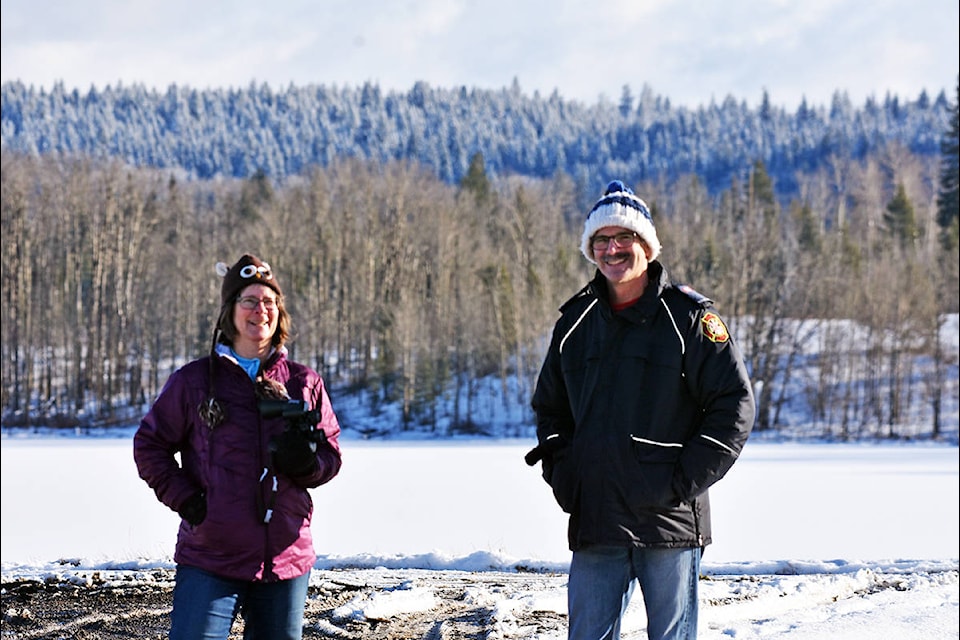A warmer-than-usual winter was a boon to local birders, who catalogued a record number of birds during the 2020 100 Mile House Christmas Bird Count.
Organizer Paul Foth who revived the count this year said 1,018 species were identified this year. While he was unable to participate in person, due to travel restrictions, he said the enthusiastic volunteers made the event a success. Some 14 volunteers split up into six teams to cover a 24-km diameter circle that extended from Horse Lake to Buffalo Creek and from 93 Mile to 108 Mile Ranch.
“A highlight of the day was a rare Northern Hawk-Owl, spotted by Barry Porter and Jill Gillingham. The striking bird is, as it sounds, something like a mix of a hawk and an owl, with piercing yellow eyes on black and white face,” Foth said. “Overall raptors were in short supply, with four Bald Eagles spotted on count day but no hawks.”
The milder temperatures meant the open water on Horse Lake and Bridge Creek yielded a healthy number of waterfowl. Susan Gower, a semi-retired educator who has lived in the community for 14 years, photographed a rarer Greater Scaup among the other ducks at Horse Lake.
READ MORE: Annual Christmas bird count returning to 100 Mile House
“I’m a birder, so I absolutely adored it. We loved meeting our new birder, Michelle Meeker, who came with us and we were outside trying to find birds. What better way to spend a day?” Gower said, adding it was her first Christmas Bird Count.
Gower said they found a lot of birds and different species in the Canim-Hendrix area and it was “just delightful” especially as she hadn’t gone birding in the area before. Her highlight was finding two Northern Pygmy Owls.
The thing that stood out the most to her, however, was how excited Meeker was to be finding birds. Being with a new birder and feeding off her excitement was great, Gower said. She said she’ll definitely do the count next year and encourages people interested in getting into the pastime to install a bird feeder in their backyard.
“If people get out there, they’ll be surprised by the number of birds in our area,” Gower said.
Meanwhile, Sue and Chris Betuzzi spotted a pair of Common Goldeneyes on a small patch of open water on the 108 Mile Lake. Sandy Proulx, Rita Proulx, and Dorri Larstone found an unusually late Tundra Swan in Bridge Creek at Centennial Park. Kathy and Peter Crawshay also added one Great Blue Heron to their long list from the Horse Lake area.
In the Canim-Hendrix area, meanwhile, Gower, Meeker and Andy Karassowitsch spied two Northern Pygmy-Owls and a few Northern Shrikes, a masked robin-sized predatory songbird. Foth said that Patricia Spencer, Eleanor Bassett, and the Betuzzis spotted an abundance of Pine Grosbeaks in the 108 Mile Ranch area, which totalled 82 of those birds for all the areas of the count.
In the zone around town and to the south, the Proulxs and Larstone spotted a Belted Kingfisher, two Townsend’s Solitaires and a couple of White-Winged Crossbills. Foth said they added some urban birds, including Eurasian Collared-Dove, House Finch and House Sparrow. The team was surprised by an out-of-season Yellow-Headed Blackbird at the 101 Mile Marsh. They also found a couple of American Dippers at Centennial Park, which Foth described as the “unique dark swimming songbirds of fast-moving water.”
Sandy Proulx, a Cariboo resident since the 90s, said he’s been involved with many bird counts over the years including the one in Quesnel, Williams Lake and Barkerville. Proulx joined this year’s bird count to help Foth out as he was in need of experienced birders to accompany the beginners. He too plans to take part in the count next year and wanted to thank Foth for co-ordinating the count.
Several volunteers also counted birds at their yards and feeders. Foth said sightings included Steller’s Jays, the recently renamed Canada Jays (formerly Gray Jay), Black-capped and Mountain Chickadees, Red-breasted Nuthatches, Brown Creepers and a slew of woodpeckers.
“Christmas Bird Count rules allow for additional species observed within the week to be included in the results. The four species that were missed on the count day but located before or after the count include Ruffed Grouse, Great Gray Owl, Black-backed Woodpecker, and European Starling,” Foth said. “Black-backed Woodpeckers are an uncommon bird that has increasingly been sighted in the burned area to the west of town, where Sandy Proulx found two after the count.”
When all was said and done Foth said that 45 species were counted, up from their usual average of 25, while 1018 total birds were seen.
“I want to thank all the participants who spent their valuable time counting the beautiful birds of the 100 Mile House area,” he said.
Species observed included a Trumpeter Swan, Tundra Swan, American Wigeon, Mallard, Lesser Scaup, Greater Scaup, Bufflehead, Common Goldeneye, Barrow’s Goldeneye, Hooded Merganser, Common Merganser, Ruffed Grouse, Great Blue Heron, Bald Eagle, American Coot, Eurasian Collared-Dove, Northern Hawk-Owl, Northern Pygmy-Owl, Great Gray Owl, Belted Kingfisher, Downy Woodpecker, Hairy Woodpecker, Black-backed Woodpecker, Northern Flicker, Pileated Woodpecker, Northern Shrike, Canada Jay, Steller’s Jay, American Crow, Common Raven, Black-capped Chickadee, Mountain Chickadee, Red-breasted Nuthatch, Brown Creeper, American Dipper, Townsend’s Solitaire, European Starling, Bohemian Waxwing, Dark-eyed Junco, Song Sparrow, Red-winged Blackbird, Yellow-headed Blackbird, Pine Grosbeak, House Finch, White-winged Crossbill, Pine Siskin, American Goldfinch and House Sparrow.
newsroom@100milefreepress.net
Like us on Facebook and follow us on Twitter.
